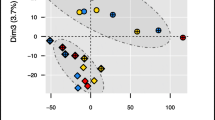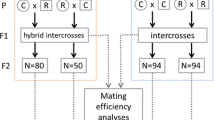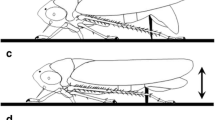Abstract
European corn borer (ECB) feeding on maize (Zea mais), mugwort (Artemisia vulgaris), and hop (Humulus lupulus) are genetically different in France and referred to as host-plant races. Here, we investigated sex pheromone composition as a possible trait linked to the host plant. ECB host races were sampled from 13 different sites in France. GC-MS analysis of female pheromone showed that 175 out of 176 maize females belonged to the Z type with one hybrid. In contrast, mugwort and hop females belonged almost exclusively to the E type. No Z females were found on these plants and only 2 females out of 169 were hybrids. In the three sites of sympatry, the hybrid proportion was far from Hardy–Weinberg expectations. Wind tunnel experiments showed that 76–79% of maize males from three populations were attracted by Z females, whereas neither mugwort nor hop males were. Mugwort males from Toussus-le-Noble were attracted by E females originating from an American maize strain. These data showed that maize, mugwort, and hop host races of O. nubilalis differ not only in their host plant but also in the sex pheromone they use. Because mugwort and hop are putative ancestral host plants, these results are discussed from the point of view of evolutionary scenarios for the emergence of Z and E strains.
Similar content being viewed by others
REFERENCES
Anglade, P., Stockel, J., and IWGO cooperators. 1984. Intraspecific sex-pheromone variability in the European corn borer Ostrinia nubilalis (Lepidoptera: Pyralidae). Agronomie 4:183–187.
Bourguet, D., Bethenod, M.-T, Pasteur, N., and Viard, F. 2000. Gene flow in the European corn borer Ostrinia nubilalis: Implications for the sustainability of transgenic insecticidal maize. Proc. R. Soc. Lond. Biol. Sci. 267:117–122.
Bourguet, D., Bethenod, M.-T, Trouvé, C., and Viard, F. 2000. Host plant diversity of the European corn borer Ostrinia nubilalis: What value for sustainable transgenic insecticidal Bt maize? Proc. R. Soc. Lond. Biol. Sci. 267:1177–1184.
Buechi, R., Priesner, E., and Brunetti, R. 1982. Das sympatrische vorkommen von zwei pheromonstämmen des maiszünslers, Ostrinia nubilalis Hbn, in der Südschweiz. Bull. Soc. Entomol. Suisse 55:33–53.
Buttlin, R. K. 1995. Genetic variation in mating signals and responses, in D. M. Lambert, and H. G. Spencer (eds.). Speciation and the Recognition Concept, Theory and Application. John Hopkins University Press, Baltimore, pp. 327–366.
Buttlin, R. K. and Trickett, A. J. 1997. Can population genetic simulations help to interpret pheromone evolution? pp. 549–562. in R. T. Cardé and A. K. Minks (eds.). Insect Pheromone Research, New Directions. Chapman and Hall, New York.
Cardé, R. T. and Roelofs, W. L. 1978. European corn borer: Pheromone polymorphism or sibling species? Science 199:555–556.
Diehl, S. R. and Bush, G. L. 1984. An evolutionary and applied perspective of insect biotypes. Annu. Rev. Entomol. 29:471–504.
Eckenrode, C. J. and Webb, D. R. 1989. Establishment of various European corn borer (Lepidoptera: Pyralidae) races on selected cultivars of snap beans. J. Econ. Entomol. 82:1169–1173.
Emelianov, I., Mallet, J., and Baltensweiler, W. 1995. Genetic differentiation in Zeiraphera diniana (Lepidoptera: Tortricidae, the larch budmoth): Polymorphism, host races or sibling species? Heredity 75:416–424.
Feder, J. L., Hunt, T. A., and Bush, L. 1993. The effect of climate, host-plant phenology and host fidelity on the genetics of apple and hawthorn infesting races of Rhagoletis pomonella. Entomol. Exp. Appl. 69:117–135.
Frérot, B., Malosse, C., and Cain, A.-H. 1997. Solid-phase microextraction (SPME): A new tool in pheromone identification in Lepidoptera. J. High Res. Chromatogr. 20:340–342.
Glover, T. J., Campbell, M. G., Linn, C. E., Jr., and Roelofs, W. L. 1991. Unique sex chromosome mediated behavioral response of hybrid male European corn borer moths. Experientia 47:980–984.
Glover, T. J., Tang, X.-H, and Roelofs, W. L. 1987. Sex pheromone blend discrimination by male moths from E and Z strains of European corn borer. J. Chem. Ecol. 13:143–151.
Guerin, P. M., Baltensweiler, W., Arn, H., and Buser, H. R. 1984. Host-race pheromone polymorphism in the larch budmoth. Experientia 40:892–894.
Hansson, B. S., Toth, M., and Roelofs, W. L. 1987. Mendelian inheritance of sex pheromone reception in male European corn borer. Naturwissenshaften 74:497–499.
Huang, Y., Takanashi, T., Hoshizaki, S., Tatsuki, S., Honda, H., Yoshiyasu, Y. and Ishikawa, Y. 1998. Geographic variation in sex pheromone of Asian corn borer, Ostrinia furnacalis, in Japan. J. Chem. Ecol. 24:2079–2087.
Huang, Y., Takanashi, T., Hoshizaki, S., Tatsuki, S., and Ishikawa, Y. 2002. Female sex pheromone polymorphism in adzuki bean borer, Ostrinia scapulalis, is similar to that in European corn borer, O. nubilalis. J. Chem. Ecol. 28:533–539.
Huang, Y., Tatsuki, S., Kim, C.-G, Hoshizaki, S., Yoshiyasu, Y., Honda, H., and Ishikawa, Y. 1997. Identification of sex pheromone of adzuki bean borer, Ostrinia scapulalis. J. Chem. Ecol. 23:2791–2801.
Ishikawa, Y., Takanashi, T., Kim, C.-G, Hoshizaki, S., Tatsuki, S., and Huang, Y. 1999. Ostrinia spp in Japan: Their host plants and sex pheromone. Entomol. Exp. Appl. 91:237–244.
Klun, J. A. and Brindley, T. A. 1970. Cis-11-Tetradecenyl acetate, a sex stimulant of the European corn borer. J. Econ. Entomol. 63:779–780.
Klun, J. A., Chapman, O. L., Mattes, K. C., Wojtkowski, P. W., Beroza, M., and Sonnet, P. E. 1973. Insect sex pheromone: Minor amount of opposite geometrical isomer critical to attraction. Science 181:661–663.
Klun, J. A. and Cooperators 1975. Insect sex pheromones: Intraspecific pheromonal variability of Ostrinia nubilalis (Lepidoptera: Pyralidae) in North America and Europe. Environ. Entomol. 4:891–894.
Klun, J. A. and Huettel, M. D. 1988. Genetic regulation of sex pheromone production and response; interaction of sympatric pheromonal types of European corn borer, Ostrinia nubilalis (Lepidoptera: Pyralidae). J. Chem. Ecol. 14:2047–2061.
Klun, J. A. and Maini, S. 1979. Genetic basis of an insect chemical communication system: The European corn borer. Environ. Entomol. 8:423–426.
Kochansky, J., Cardé, R. T., Liebherr, J., and Roelofs, W. L. 1975. Sex pheromone of the European corn borer Ostrinia nubilalis(Lepidoptera: Pyralidae) in New York. J. Chem. Ecol. 1:225–231.
Linn, C. E., Jr. and Roelofs, W. L. 1995. Pheromone communication in moths and its role in the speciation process. in D. A. Lambert and H. G. Spencer (eds.). Speciation and the Recognition Concept, Theory and Application. John Hopkins University Press, Baltimore, pp. 263–299.
Linn, C. E., Jr., Young, M. S., Gendle, M., Glover, T. J., and Roelofs, W. L. 1985. Sex pheromone blend discrimination in two races and hybrids of the European corn borer moth Ostrinia nubilalis. Physiol. Entomol. 22:212–223.
LÖfstedt, C. 1990. Population variation and genetic control of pheromone communication systems in moths (mini-review). Entomol. Exp. Appl. 54:199–218.
LÖfstedt, C. 1993. Moth pheromone genetics and evolution. Phil. Trans. R. Soc. Lond. B 340:167–177.
LÖfstedt, C., Hansson, B. S., Roelofs, W., and Bengtsson, B. O. 1989. No linkage between genes controlling female pheromone production and male pheromone response in the European corn borer, Ostrinia nubilalis Hübner (Lepidoptera: Pyralidae). Genetics 123:553–556.
Martel, C., Rejasse, A., Rousset, F., Bethenod, M.-T, and Bourguet, D. 2003. Host plant associated genetic differentiation in northern French populations of the European corn borer. Heredity 90:141–149.
Mayr, E. 1994. in Hermann (ed.). Populations, Espèces et Évolution. Editeur des Sciences et des Artes, Paris, 496pp.
Nojima, S., Linn, C. E., Jr., Morris, B., Zhang, A., and Roelofs, W. 2003. Identification of host fruit volatiles from hawthorn (Crataegus spp.) attractive to hawthorn-origin Rhagoletis pomonella flies. J. Chem. Ecol. 29:321–336.
Paterson, H. E. H. 1985. The recognition concept of species, pp. 21–29, in E. S. Vrba (ed.). Species and Speciation. Vol. 4 (Transvaal Museum Monograph).
Peña, A., Arn, H., Buser, H., Rauscher, S., Bigler, F., Brunetti, R., Maini, S., and Tóth, M. 1988. Sex pheromone of European corn borer Ostrinia nubilalis: Polymorphism in various laboratory and field strains. J. Chem. Ecol. 14:1359–1367.
Renwick, J. A. A. 1994. Oviposition behavior in Lepidoptera. Annu. Rev. Entomol. 39:377–400.
Roelofs, W., Glover, T., Du, J.-W, Tang, X.-H, Robbins, P., and Eckenrode, C. J. 1985. Three European corn borer populations in New York based on sex pheromone and voltinism. J. Chem. Ecol. 11:829–836.
Roelofs, W., Glover, T., Tang, X.-H, Sreng, I., Robbins, P., Eckenrode, C. J., LÖfstedt, C., Hansson, B. S., and Bengtsson, B. O. 1987. Sex pheromone production and perception in European corn borer moths is determined by both autosomal and sex-linked genes. Proc. Nat. Acad. Sci. U.S.A. 84:7585–7589.
Schluter, D. 2001. Ecology and the origin of species. Trends Ecol. Evol. 16:372–380.
Straub, R. W., Weires, R. W., and Eckenrode, C. J. 1986. Damage to apple cultivars by races of European corn borer (Lepidoptera: Pyralidae). J. Econ. Entomol. 79:359–363.
Tauber, C. A. and Tauber, M. J. 1989. Sympatric speciation in insects: Perception and perspective. in D. Otte and J. A. Endler (eds.). Speciation and its Consequences. Sinauer Associates, Sunderland, UK, pp. 307–344.
Thomas, Y., Bethenod, M.-T, Pelozuelo, L., Frérot, B., and Bourguet, D. 2003. Genetic isolation between two sympatric host plant races of the European corn borer, Ostrinia nubilalis Hübner. I—Sex pheromone, moth emergence timing and parasitism. Evolution 57:261–273.
Via, S. 2001. Sympatric speciation in animals: The ugly duckling grows up. Trends Ecol. Evol. 16:381–390.
Via, S., Bouck, A. C., and Skillman, S. 2000. Reproductive isolation between divergent races of pea aphids on two hosts. II. Selection against migrants and hybrids in the parental environments. Evolution 54:1626–1637.
Zhao, C.-H, Lu, F., Bengtsson, M., and LÖfstedt, C. 1995. Substrate specificity of acetyltransferase and reductase enzyme systems used in pheromone biosynthesis by Asian corn borer, Ostrinia furnacalis. J. Chem. Ecol. 21:1495–1510.
Zhu, J. W., Zhao, C.-H, Lu, F., Bengtsson, M., and LÖfstedt, C. 1996. Reductase specificity and the ratio regulation of E/Z isomers in the pheromone biosynthesis of the European corn borer, Ostrinia nubilalis. Insect Biochem. Mol. Biol. 26:171–176.
Author information
Authors and Affiliations
Corresponding author
Rights and permissions
About this article
Cite this article
Pelozuelo, L., Malosse, C., Genestier, G. et al. Host-Plant Specialization in Pheromone Strains of the European Corn Borer Ostrinia nubilalis in France. J Chem Ecol 30, 335–352 (2004). https://doi.org/10.1023/B:JOEC.0000017981.03762.ed
Issue Date:
DOI: https://doi.org/10.1023/B:JOEC.0000017981.03762.ed




